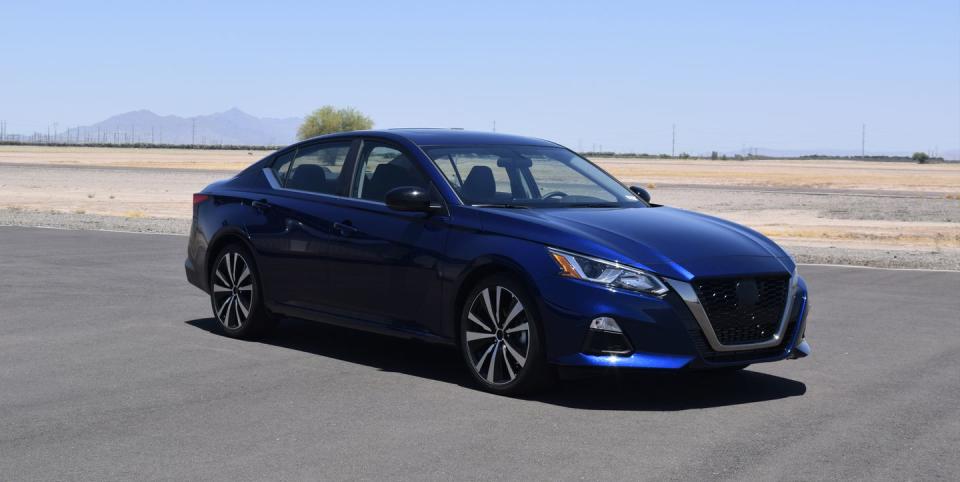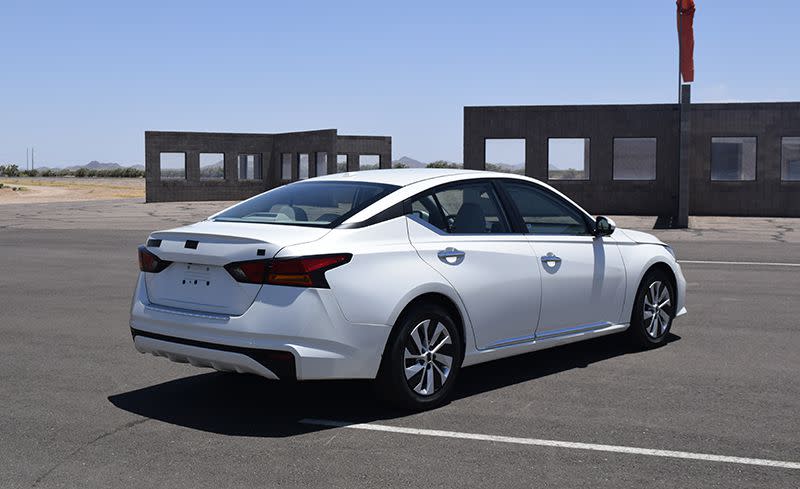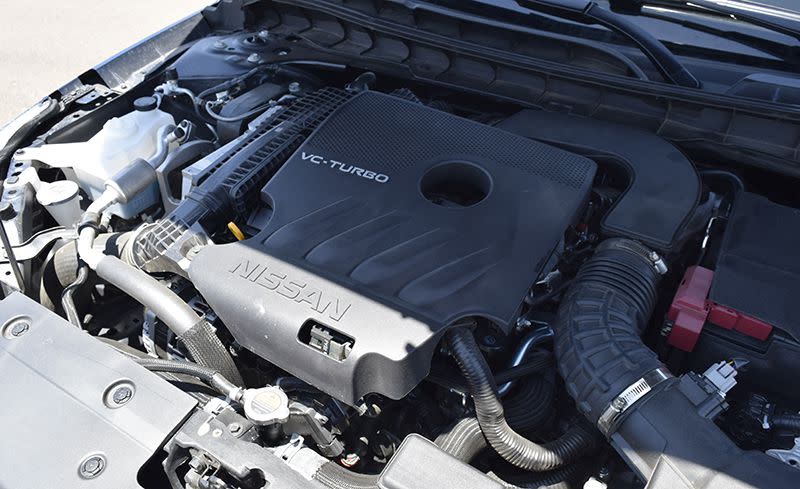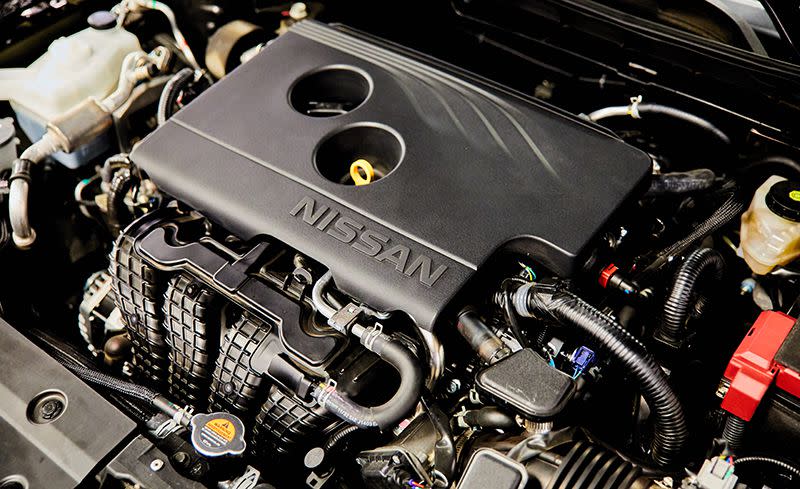We Drove 2019 Nissan Altima Prototypes and All We Can Tell You About Are the All-New Four-Cylinder Engines

It may be hard to believe, but the Nissan Altima has had the same two engine options for more than 15 years. The current 2018 Altima uses the same basic 2.5-liter inline-four and 3.5-liter V-6 engines that debuted with the 2002 model. Code-named QR25DE and VQ35DE, these engines have received minor updates over the years, but a comprehensive powertrain overhaul has been overdue for some time. That’s especially true now that the Nissan’s two heavy-hitter rivals, the Honda Accord and the Toyota Camry, are freshly redesigned.
The Altima is now getting a redesign of its own for 2019, and it includes an underhood update in the form of two new four-cylinder engines. The base engine is again a naturally aspirated 2.5-liter inline-four, and it even shares the same block and cylinder head as the old engine. But Nissan claims that 95 percent of the parts are new, and the engine gets a new code name: PR25DD. Direct injection replaces the old port-injection system, the compression ratio rises, and horsepower and torque each increase slightly. The Altima’s upgrade engine represents an even more significant change: The V-6 is gone, and in its place is a turbocharged 2.0-liter inline-four with Nissan’s new variable-compression-ratio tech; this same engine (code-named KR20DDET) made its debut in the 2019 Infiniti QX50.
We’ve just experienced both of these engines in a trio of 2019 Altima prototypes at the company’s proving grounds in Arizona. And while we can’t yet talk about the Altima’s ride and handling characteristics until closer to the on-sale date this fall, we can share how these two new engines feel, sound, and behave in the redesigned mid-size sedan.
2.0T VC-T: Complex but Conventional
No other automaker can claim to have anything like the tech offered in the Altima’s turbo four. Called VC-T or VC-Turbo-for Variable Compression Turbo-this 2.0-liter engine can vary its compression ratio from 14.0:1 to 8.0:1 to maximize either fuel efficiency or power. We’ve detailed the system thoroughly before, but to sum up, it’s all achieved through a complex system that adds a link between the crankshaft and the connecting rod. An actuator changes the angle of the link to vary the relative position of the pistons in the cylinders, thus changing the compression ratio.
This all adds up to fairly ordinary numbers for a turbocharged 2.0-liter four: 248 horsepower and 273 lb-ft of torque; that’s down 20 hp and 7 lb-ft from the QX50, due to different tuning and the Altima’s diet of regular fuel in place of the Infiniti’s required premium. But Nissan expects the VC-Turbo to deliver higher fuel-economy numbers than other 2.0T competitors. EPA estimates aren’t available yet, but that would mean topping the Honda Accord 2.0T’s 27-mpg combined rating and the Chevrolet Malibu 2.0T’s 26 mpg.
Despite what the advanced tech might suggest, the VC-T behaves rather like other 2.0-liter turbo fours, with strong low-end torque and a linear power curve. Only its somewhat guttural exhaust note and lowish redline of 6000 rpm give the engine away as something unusual.
We drove both SR and Platinum-trim cars, which had the 2.0T combined with a continuously variable automatic transmission (CVT)-the only transmission available with either engine. The VC-T’s distinctive sound added a measure of sporty character to the Altima, and it felt predictably stronger and torquier than the 2.5-liter car throughout the rev range. But the VC-T is a bit less refined than the naturally aspirated mill, being more aurally present, and transmits more vibration into the cabin than the base engine. While we admit that it’s amazing that this engine can behave so normally given its abnormal internal tricks, the increase in overall NVH isolation is at odds with the VC-T’s position as the premium powertrain, especially given the exceptional smoothness and polished demeanor of the Accord’s 2.0T.
2.5L: Gone to Finishing School
In the base-model 2019 Altima S with the 2.5-liter four-cylinder, CVT, and front-wheel drive, we were impressed by the new engine’s refinement. The old 2.5-liter was grainy and coarse, with unseemly vibrations and an annoying amount of noise under hard or even moderate acceleration. The new engine not only revs smoothly, it sounds hushed even at higher revs as the structure does a better job of isolating it from the cabin.
Peak power increases by 9 horsepower to 188, while torque climbs to 180 lb-ft from 177 lb-ft, which is not enough for a noticeable difference in flat-out acceleration (a 2018 Altima 2.5L went from zero to 60 mph in 8.0 seconds in our testing) without a significant weight loss. The sensation when you put your foot down is far more pleasant, though, thanks to the retuned CVT, which uses more sharply defined artificial “shift” points to mimic a conventional gearbox and minimize droning.
Nissan is targeting a 1-mpg improvement in the EPA’s combined fuel-economy cycle, which would put it at 32 mpg, still a bit behind the Accord and Camry’s best combined ratings of 33 mpg and 34 mpg. The real ace up the base-engine Altima’s sleeve may be its new all-wheel-drive option, which we did not experience. Available only with the 2.5-liter engine (Nissan says that AWD doesn’t work with the turbo four in the Altima for packaging reasons), it’s expected to be popular in the Northeast, and it earns the Altima entry into the fairly exclusive club of mainstream mid-size sedans offered with AWD, which currently includes only the Subaru Legacy and the Ford Fusion-and the Fusion is being phased out.
The 2019 Altima has its eyes set on the top of this highly competitive segment, a tall task given the excellence of many of its foes. The two new engines carry significant advantages over their predecessors, although our final assessments will have to wait until we can subject them to our instrumented testing and real-world fuel-economy regimens. Until then-and until we can share our full impressions of this new mid-size sedan-we’ll simply have to leave it at this: Things look promising for the Altima now that it has legitimately new engines for the first time since flip phones were popular.
You Might Also Like

 Yahoo Autos
Yahoo Autos 


